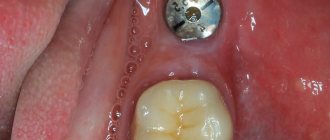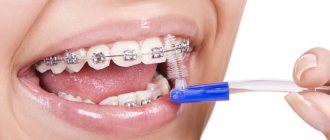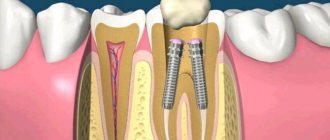“ – Doctor, the crown on my tooth is loose, what should I do?
” This question is not uncommon in the dental office. Patients do not always understand why, instead of simply fixing the crown, the doctor prescribes an examination.
The orthopedist’s task is not just to fix the prosthesis, but to find out the reason why the crown is loose after installation.
Without an examination, it is impossible to make an accurate diagnosis, and if the cause is not eliminated, the problem will arise again and again.
What causes the crown to become loose?
Part of the dental examination is taking an anamnesis, especially if the denture is several years old and you came to a different doctor with a problem than the one who installed it.
The fact is that there are objective reasons for the loosening of crowns.
Dental cement changes its structure over time, and its adhesive (adhesion-promoting) properties are lost. The crowns on the front teeth become loose especially often, because each bite leads to less grip.
Another objective reason is gum recession (loss). With age, the gums sag, covering the roots less and less. A gap forms between the restoration and the gum, where food debris gets in and colonies of bacteria begin to flourish. They destroy hard tissues, the stump becomes smaller, and the prosthesis cannot stay on it.
Therefore, dentists recommend replacing crowns regularly. Most often, a metal-ceramic crown wobbles, because the stump is heavily ground down for it, and the structure itself is massive, with thick walls. The service life of such crowns is the shortest: 5-7 years
. The stronger the material, the thinner the crown, the better the fit, and therefore the longer the service life. Therefore, ceramic restorations and products made from zirconium dioxide can be worn for decades.
But there are other reasons why the crown on a tooth becomes loose.
- Incorrect preparation
The stump for prosthetics must meet certain requirements: slightly taper towards the lower edge, be at least 3 mm in height (4 mm for molars).
If the doctor did excessive grinding, then the crown will slide off the tooth like a slide, even in the presence of cement. There should be a minimum gap between the tooth stump and the walls of the crown. The smaller the gap, the more reliable it is.
Perhaps the tooth was initially short and the doctor did nothing to grow it to the desired size. You can glue the crown, but it will still fall off. The higher the tooth, the better the crown is fixed on it.
The solution to the problem is to build up the stump with composite materials or inlays.
- Problems with cement
Dental materials are expensive and some clinics buy cheap materials from unknown manufacturers. Patients suffer from such savings.
Another case is when the cement is of high quality, but the technology for its preparation has been violated. The adhesive properties of such cement will not be good enough for the prosthesis to last for several years.
When re-prosthetics or re-installation, it is necessary to maintain proportions when mixing cement and use a quality product.
- Violation of manufacturing technology
The quality of the crown depends not only on the orthopedist, but also on the technician who makes it. A qualified technician follows all the requirements for the manufacturing process and always carries out sandblasting. It makes the inner surface rough, and this increases adhesion (adhesion).
Compliance with manufacturing requirements will improve the quality of the prosthesis and extend its service life.
- Loss of hard tissue
Before prosthetics, teeth are often depulped and the nerve (pulp) is removed. Therefore, during caries, the tooth under the crown does not hurt, but it can be destroyed. If caries destroys most of the hard tissues, the crown will begin to wobble, because the volume of the stump will decrease.
The patient himself can understand that the tooth under restoration is inflamed only by the smell from under the crown. In dentistry, for diagnosis, a targeted photograph is used, in which the lesion is visible. After treatment, the orthopedist will build up the stump or use microprostheses before installing the crown. If the tooth cannot be saved, it will be removed. The dentition can be restored with a bridge or implant. Implantation will avoid grinding down adjacent teeth and prevent bone loss. The bridge cannot stop atrophy.
How to choose a pin, by what criteria
Metal pins
There are several criteria for choosing pins, but this is definitely not a price indicator. The decision to use one design or another is made by a specialist.
The main factors influencing the choice of pin:
- extent of tooth damage, condition of dentin;
- root canal parameters;
- level of load on the tooth being restored;
- immersion depth;
- the expected or required service life of the structure;
- channel wall thickness;
- condition of the roots, dentin around the causative tooth;
- material used in the production of rods.
Reasons for loosening of the crown on the pin and inlay
The reason that the crown on the pin began to wobble depends on cementation and correct installation:
- When bonding with dental cement, the quality of the material is of great importance. Its task is to seal the gap between the tooth, the pin and the crown.
- Incorrect installation of the pin (fiberglass pin) in the channel. To use a post, it is important that most of the tooth is preserved. The pin is responsible for stability, but the crown is held on the tooth. If the pin is poorly secured or the tooth is severely damaged, the denture will wobble.
The inlay, unlike the pin, consists of two parts, the pin itself and an element that replicates the tooth. The crown on the inlay is loose if:
- de-cementing occurred;
- parts of the tab have become disconnected.
Re-prosthetics in cases where pins and inlays are used will take longer. It is necessary to install microprostheses in compliance with the technique, correct the defects that led to the loss, and then install a new crown. Attempts to fit a microprosthesis to an old restoration will lead to the fact that the entire structure will have to be changed again.
Pin or implant? What to choose?
What is an implant
What is a pin and how is it different from an implant?
How does a pin differ from an implant?
Pin or implant? This question worries many who decide to restore lost teeth. To make a decision, it is important to understand the difference between these designs. Both the post and the implant support the crown. However, they perform different tasks and are installed in different clinical situations. Let's take a closer look at each of them.
Reasons for loosening of the crown on an implant
If the crown is fixed to the adapter (abutment) with cement, then the most common reason for loosening is poor quality of the material. With screw fastening, the prosthesis is fixed with special screws onto the implant, which acts as a root. This method is considered more reliable compared to cement fixation. But the fastening is subject to load from different sides and the screw may loosen.
The doctor can easily strengthen a loose crown simply by tightening the screw. Screw fastening is more expensive, but as a result, the crown does not have to be replaced every time it becomes loose. The dentist can better see the progress of implant healing and work with screw-based dentures much easier.
What to do if the crown on the implant is loose? You must consult a doctor immediately. This may be a symptom of implant rejection or inflammation of the tissue around it. In such cases, special treatment is necessary.
Other causes of pain
One of the common causes of pain is the development of inflammation. This process begins approximately 1-2 days after the pin is installed and may indicate that the soft tissue was damaged during the procedure and became infected. In the oral cavity, infection occurs quite quickly, so you should not postpone a visit to the doctor for treatment - this is fraught with complications.
There is also such a thing as congenital tooth sensitivity. Usually the patient is aware of this peculiarity. Pain occurs, for example, due to chewing hard food or when eating food that has a contrasting temperature (very cold or hot).
Interesting ! The pain occurs due to congenital sensitivity of the teeth.
Temporary crowns
The implantation process involves a fairly long (depending on the protocol) waiting period for the artificial root to take root. During this time, the patient is fitted with temporary prostheses.
Temporary crowns are made from inexpensive materials that do not have sufficient rigidity. If you don't take good care of them, infection can easily get to the tooth. Therefore, in most cases, the reason why a temporary crown on an implant becomes loose is non-compliance with the rules of care and excessive chewing load.
Removing a dental post
The pin is removed in the following situations:
- if the apical part of the root becomes inflamed;
- when a filling needs to be replaced;
- during the preparatory stage before implantation;
- with unprofessional and poor-quality installation of the pin.
Removal of the pin is carried out in several stages. First, old fillings, crowns and other structures installed earlier are removed. Then, using ultrasound, the cement holding the pin is destroyed.
After this, you can directly remove the pin using forceps.
Important! If the pin is very firmly fixed in the root canal of the tooth, then ultrasound treatment is performed - due to vibrations, the pin moves, and this makes it easy to remove it.
After the procedure is completed, the doctor must check the patency of the root canals.
The doctor will definitely check if everything is in order after the procedure.
The pins are removed painlessly; this procedure does not pose any danger to the patient. Even anesthesia is not used in this case - only vibration and light pressure are felt.
Analogues of the procedure
Stump tab
An alternative method, which is used in case of severe tooth decay, is the installation of a stump tab. It is a microprosthesis manufactured according to the patient’s individual parameters in the laboratory.
The essence of the operation is to fix the lower part of the tab into the dental canals. The crown is attached to the free upper part of the prosthesis.
The cost of a stump inlay is on average 2,200 rubles.
Application in dentistry
The practice of restoring a tooth on a pin has been around for a long time. Since then, of course, both materials and technologies have changed, thanks to which it has become possible to use it not only to restore a damaged tooth, but also for other purposes.
- building up teeth onto a post, or more precisely their crown part when it is significantly destroyed, remains the main direction of their use to this day;
- Very often, dentists use the method of prosthetics with pins if it is not possible to attach a fixed bridge prosthesis to adjacent teeth. By the way, dentures on pins are held much stronger;
- often a pin insert is used to reinforce a tooth with removed pulp;
- in dental treatment, pins are used not only individually, but also as part of complex combined structures that splint teeth in case of periodontal diseases;
- A rare, but still used today operation to replant a patient’s own teeth is also not complete without installing a pin in the place of the extracted tooth, since without it there is simply nothing to support the replanted tooth. Although such pinned teeth look natural, over time they can lose their natural appearance due to lack of nutrition. That is why, in case of dislocations and fractures, if it is not possible to preserve, for example, a healthy front tooth, the doctor recommends installing a prosthesis.
Contraindications
Pins help restore a beautiful smile in many, even very difficult cases. However, there are still limitations to the implantation of the structure:
- when a cyst or granuloma is detected;
- if an inflammatory process in dentin is detected;
- for root canal pathologies (curvature, blockage, etc.);
- when the canal walls are very thin.
Experts do not recommend performing the procedure of implanting a rod during pregnancy. But this issue is resolved by postponing the operation for several months.
Advantages and disadvantages
Pins have a number of advantages, which explains their popularity. But to really evaluate the restoration element, you should familiarize yourself with all the pros and cons.
| Pin analysis | |
| Advantages | Flaws |
| the ability to restore missing teeth in a row or restore severely damaged ones | an error made during the manufacture of the pin or its installation can cause complications |
| the materials used to make the pins have hypoallergenic properties | when removing the pin (metal), all materials are removed along with the root |
| The design is durable and holds the crown securely | There are cases when the pin does not take root; rejection occurs due to an allergy to the material. |
| low weight reduces the load on the canal tissues | During operation, the pin contributes to the thinning of the canal walls, which leads to tooth loss |
| non-metallic pins are flexible, which contributes to long-term operation of the structure | |
| long service life eliminates frequent visits to the clinic to replace bridges or install fillings | |
| aesthetics combined with practicality | |
Rehabilitation period
Despite the fact that the operation of implanting a pin is an ordinary procedure, after the manipulations the patient must follow some rules.
- After the pinning operation, the doctor prescribes antibiotics and, if necessary, other drugs. All instructions must be followed according to the scheme, otherwise the risk of developing an inflammatory process will increase, which will lead to rejection of the structure.
- oral hygiene procedures, Brushing your teeth should be done twice a day.
- The menu is designed to include soft food dishes. To do this, during cooking, it is better to grind the food with a grater or blender.
- You should forget about toothpicks , at least for a while until the wound heals. Any mechanical loads can provoke rejection of the pin from the soft tissues.
What it is
In the absence of timely treatment of a damaged tooth, the process of crown destruction can reach such a state that it becomes impossible to restore the tooth without additional support. In such cases, if the roots are suitable for prosthetics, it is customary to use a pin in the treatment of a damaged tooth. This is done in order to preserve the natural structure of the jaw and avoid deformation of the dentition.
The design allows you not only to preserve your own viable tooth root, but also to save on a prosthesis, since a tooth with a pin will cost you much less than prosthetics.
A dental post is a ready-made, factory-made or specially made structure based on an impression, which is fixed in a pre-processed root canal and serves as a support for an artificial crown or a permanent bridge. For installation, four conditions must be met: the thickness of the root walls is at least two millimeters, the ability to unseal the root canal by 2/3 of its length, completely obturate the canal and give it a conical or cylindrical shape.
Restoration of teeth using cast core inlays
This is one of the most reliable and proven methods of restoring a tooth stump.
A cast stump inlay is essentially an individual pin cast from metal, strengthened in the tooth canal with cement, and restoring the supragingival part of the tooth.
This is a monolithic structure without seams or joints, and therefore very durable and resistant to significant loads. Do you still have questions about restoring a damaged tooth using a therapeutic method? Get a free consultation from specialists. Registration is open online on the clinic website!










